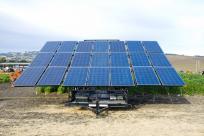 Transmission Stalls Solar GrowthApr 2, 2010 - Bill Opalka - renewablesbiz.com
That's the bad news, said one prominent renewable energy finance expert. I recently spoke to Ed Feo, co-chair of the power, energy and utility practice at the law firm Milbank, Tweed, Hadley & McCloy. "Generation is always easier and quicker to build when it comes to the siting and financing issues that are involved," he said. "So we expect there will be a lot of attrition in the number of transmission projects that are already in the queue." Large-scale solar projects are going to have a difficult time getting financed if the developers can't find transmission access at a cost that they can afford. Feo estimated that there are more than 800 megawatts of signed power purchase agreements in process and another 20,000 megawatts in the queue without signed contracts. Overall, the industry will have to determine a strategy to develop solar assets throughout the Southwest to get projects in Arizona, Nevada and even New Mexico to feed into the California market. Concentrating solar power projects, often several hundred megawatts in size, are the scaled projects counted on to help California meet its renewable energy mandate targets. But a lot of attention has been paid lately to efforts to expand the size of the national monuments in California, effectively killing potential development there. That has forced some developers to look elsewhere. Besides transmission costs and environmental impacts, other barriers include water use and the exacting standards set out in the federal loan guarantee process. The outlook for projects that don't face those issues as much may fare better. "We will still see significant development of the smaller, utility-scale photovoltaic projects in the sub-100 megawatt range," Feo said. And for that, developers can feel grateful. The editorial staff at RenewablesBiz.com is passionate about exchanging ideas and dedicated to promoting ongoing conversation about renewables and sustainable energy issues. We invite you to join and contribute to our online community. If you have an idea for an article or editorial contribution, please contact me via email, bopalka@energycentral.com, or phone, 860.633.0090. |
Email this page to a friend


 Power purchase agreements and project finance are two of the legs on the stool for renewable energy's growth, but the third leg, transmission access, is turning into a problem for large solar projects in the Southwest.
Power purchase agreements and project finance are two of the legs on the stool for renewable energy's growth, but the third leg, transmission access, is turning into a problem for large solar projects in the Southwest.